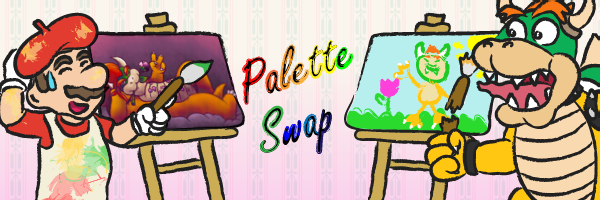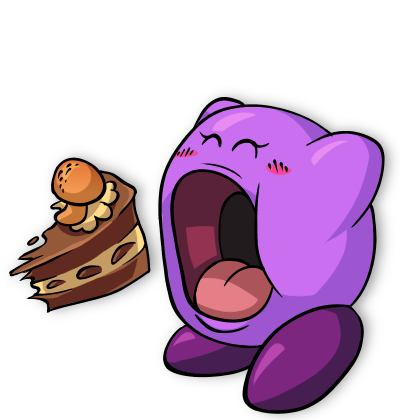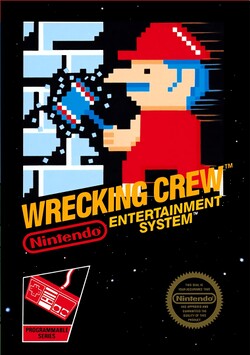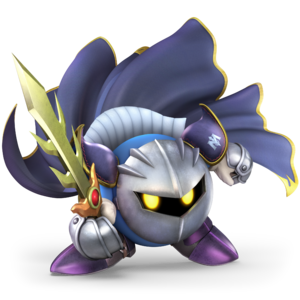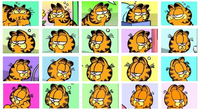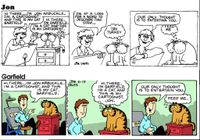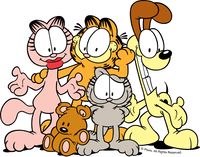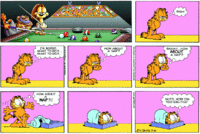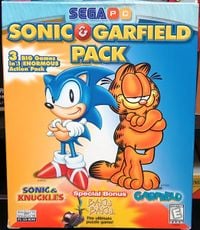The 'Shroom:Issue 156/Palette Swap
Director's Notes
March into the March Issue of Palette Swap!
Boy have I been busy. New job brings a whole host of lifestyle changes, plus I've been under the weather lately, so things have been hectic. I'm ready to put my winter coat away and frolic in the sunshine of spring!
When I was first setting up this month's issue, the coronavirus panic hadn't really hit yet... but now my entire state is pretty much on lockdown, and I'm just trying to keep my elderly relatives safe. Things are getting scary out there, but I have faith that things will get better. They might get worse before they get better, but they will get better. Just keep your head up and keep washing your hands!
I mentioned that a new section is starting this month, and I'm happy to welcome winstein (talk) with a new section talking about the history of newspaper comic strips. It's a new style of section for us, I think, and it's a fantastic read, so don't miss it!
Read on! ~FunkyK38
Section of the Month
A NEW CHALLENGER APPROACHES! Congratulations to Magolor04726 (talk) for his first Section of the Month for the very first section of World of Plight! It was a tough race last month, there were three excellent sections for you all to vote for. A big thank you to everyone who voted, and please keep it up for this month, too!
| Palette Swap SECTION OF THE MONTH | ||||
|---|---|---|---|---|
| Place | Section | Votes | % | Writer |
| 1st | World of Plight | 10 | 47.62% | Magolor04726 |
| 2nd | Mario's Boombox | 6 | 28.57% | Hooded Pitohui |
| 3rd | What's on the Box? | 5 | 23.81% | Yoshi876 |
What's on the Box?
Hello readers, and welcome back to What's on the Box.
Last month, we looked at an obscure spin-off, and although this spin-off isn't more obscure, I would say it's hardly a spin-off on the tongues of everyone, as we look at the construction game? Wrecking Crew.
Other than glancing around the wiki's page for this game, I really have no idea what this game actually is. From what I can gather, you essentially just have to destroy a lot of stone walls, like a wrecking crew would. The boxart for the game demonstrates that, by having a figure that somewhat resembles Mario destroying walls with a hammer, but other than that there's nothing else to say about this particular box. Given the fact the character on the front just about resembles Mario, I'm not even sure if at first glance I would've known this was a Mario game.
And that is quite the issue for a game, where you can't even tell what series it is from by looking at the boxart. I respect this was a game from around the 1980s, and predates the first Super Mario Bros. game so I'm hardly expecting it to be a fully-realised render of our favourite plumber / demolition man, but perhaps something that could tip you off that this is the same guy from Mario Bros. or even Golf would be appreciated.
Given limitations of the time period, to expect this boxart to be on par with something like Super Mario Odyssey is somewhat ridiculous, but to still try and set a consistent image for what Mario should be would be a lot more appreciated. I don't think the passing 80s buyer would've associated this with a Mario title, even though he might not have been such an established name by then, and for me that is a small issue. If you're trying to build a franchise, I think a consistent image of the main hero might go a long way.
World of Plight
Written by: Magolor04726 (talk)
Magolor's note: If you haven't read the other entries, you may want to before you read these ones to fully understand the story.
Wario
tha cafitera was out of garlic booritoes today!!!!! that is unakseptiabal reedikyoolus rong!!!!! (thayre we go.) i mean, wat do they xpect me too eet? plane barritos? evr sinse mi ferst samsh bros thing thayve had garlic buritoss in thuh mes hal. y wud thay run owt now?
Meta Knight
So Magolor04726 is making a compilation of our current events? I mustn’t say I’m too surprised. He always was a writer. I certainly hope the story is interesting to read. I must confess, his codename is most definitely odd. Naming one’s self after one who attempted to destroy us and rule our world? I will never understand human motivation.
With every fight, my opponents seem to become more and more reckless, in the sense that they wish to defeat me for reasons besides the obvious. Perhaps the cause may be that Master Sakurai had to reduce my power before each event since 2009. No matter the situation, I will forever fight for honor and valor with Galaxia by my side.
A most strange occurrence has arisen. No one has seen King Dedede in almost a week. It makes me wonder… he can’t possibly have gone back to Dream Land, and the Fountain of Dreams hasn’t been used in a while, so he won’t be there either. The Replay Movie Theatre has no record of him attending recently, and he hasn’t checked in for training lately either. But what’s most disturbing is he has not shown up at Main Menu Mess Hall for any meals. I know he’s lazy, but it’s not like him to disappear. Perhaps Taranza has kidnapped him again… but you cannot get into Smash without invitation, even if it is just to have a spirit or trophy modeled after you, and no such letter was ever sent. If he has been kidnapped, it would be most alarming, as one would have to be incredibly powerful, not just to overpower the king, but to get past the many precautions intended to stop events similar to this. I must express my concerns with Master Sakurai before my next tournament…
Hey guys! Thanks for reading “World of Plight”, and I hope you really enjoy it so far! If you have ideas for who I should interview next, if you have questions or if you want to chat, contact me on the Mario Boards.
Cooking up a storm, Magolor04726, Honorary Meta Knightmare member
Drawn & Pressed
As one of the few comic strips that attained worldwide popularity, Garfield is practically well-known to people who aren't into the hobby. As to how I was introduced to it, in the paper that we usually ordered, Garfield was positioned at the top-left corner, which would make it the first comic to be noticed. The comic is immediately eye-catching, thanks in part to its panel structure, artwork and overall simplicity, and thus Garfield is the first comic strip that caught my eye as a favourite. Not every comic strip back then still runs on the paper, but Garfield remains as one of the active comic strips. Because of how my interest in comic strips started in this comic, Garfield is the most appropriate comic to start out within this series of articles.
If you gleaned through the Garfield comics from his first year to the current year, you may notice that Garfield's art style constantly evolved. He started out as a bulky cat with small eyes that cannot walk on two legs easily, to a more slender cat (though still retaining a round tummy) with larger eyes and can easily walk on two legs. In fact, Garfield has had a meeting between his past self and his then-present self, as a lead up to his birthday. Did I mention that Garfield is notable for celebrating his birthday every year on 19th of June without fail, except on his first day (he did on his second day)? Because of how Garfield made a big deal on his birthdays, we're being reminded yearly about it, meaning that Garfield's first day is comparatively more known than most other comic characters. Other comics might have milestone celebrations, but they don't always have a constant birthday reminder to inform people when they started.
Although Garfield had official started in 19th June of 1978, it wasn't really the first time Garfield appeared, since he first appeared in the Pendleton Times-Post under the title Jon[1]. As its name suggests, Jon was the focus while Garfield was a prominent side character. Elements from Garfield's past life can be found in the early years of the present run, such as the first comic, along with one where Jon looking at a bachelor's magazine (in which Garfield didn't appear, and that seems to have bothered some people if this is of any indication). Given how Jon is still a prominent character in the comic, I like to think that Jim Davis still has had Jon in mind since he was the previous main character, after all. The seminal strip changed its name to Garfield later, under the direction of the editors who noted Garfield's more star-worthy material compared to Jon, given how Jim Davis pitched the strip as one where Jon's cat would have the "snappy comebacks". Indeed, Garfield's penchant for one-liners and snappy comments eventually resulted in his overnight popularity.
According to Jim Davis, Garfield's creation was motivated due to his creator wanting to make a marketable character, which can also infer that he had money in mind when he created Garfield. Jim Davis' motive behind this strip's creation is usually used by his detractors on how soulless and unfunny Garfield is, but this is a very narrow-minded way of looking at it. After all, money as motivation in creating a work is not some condemnation for its quality, since there are quite a number of works that were made with money in mind, such as The Godfather (novel). It's more that Jim Davis accurately gauged the market needs, which is in fact an unpredictable exercise itself. In this case, the author made a comic with a cat character since cat-focused comics are something of a void back then. Fortunately, Garfield managed to prosper because people are taken to a cat character quite easily, and it helps that Garfield is a likable character on his own. You can't do that if the motivation for money is hollow (example: the creation of bootleg products). There's also the fact that the works that resulted from Garfield have earnest effort put in, which includes the animated series. So basically, although Jim Davis acknowledged his monetary motivation, it's not a bad thing since he did create a legitimately lovable and famous character, which I need to point out is not very easy to do and I daresay, enviable. Garfield's immense popularity resulted in him being THE cat of comic strips. Even Heathcliff, who was created earlier than Garfield, didn't manage to attain Garfield's popularity. In fact, it wouldn't be surprising that Heathcliff started to be more well-known due to Garfield's popularity rubbing off on any orange cats, including even real ones!
The fact that Jim Davis managed to create something that's famous with a business perspective in mind is interesting, and certainly different from well-known series with a more artistic motive. The flipside is the case for another comic about a cat: Krazy Kat, who was lucky to have a publisher (William Randolph Hearst) who loved the comics, that the author, George Herriman, managed to obtain a platform to publish his works and become famous and influential as a result. There are quite a number of comic strips that were made with a bigger focus on the business side of things, but they basically faltered. One such example would be Robotman, basically created by a musician who collaborated with United Features Syndicate for the purpose of merchandising and selling a comic strip. Unfortunately, Robotman hardly resonated with the public, so the very character that was designed to sell merchandise was introduced to Monty, who was introduced to allow that cartoonist to exert his better comedic strengths, and then Robotman was written off, essentially leaving Monty as the titular character.
- “I’d like to say it was some sort of a divine inspiration that created the strip. In fact, it wasn’t so much that as a conscious effort to come up with a good, marketable character. I’ve been trying to get syndicated for eight years. That’s a lot of time to try to figure out what makes some strips go and others fail. It’s essentially a formula. I notice dog strips are doing well, and I knew an animal strip would be strong. People aren’t threatened by an animal. They have a lot of latitude. Do a lot of things that humans can’t. By virtue of being a cat, Garfield’s not black, white, male or female, young, or old or a particular nationality. He’s not going to step on anyone’s feet if these thoughts are coming from an animal. So that was my first theory.”
- —Jim Davis[2]
Garfield's merchandising reach could really only be rivaled by Peanuts, since not only is he still chugging along in the world of comic strips, he's got a few shows and specials, films, video games and indeed, a truckload of merchandise bearing his and his friends' faces. The company that Jim Davis set up to manage Garfield as a property, Paws Inc., hosted a history of merchandise that would have made for a fascinating museum until they were sold on eBay and the leftover merchandise scattered across prospective buyers and/or fans. Some of them might even be lost and found, as is the case of the Garfield telephones being washed ashore at France[3]. Of course, Peanuts still reigns supreme since it managed to be big enough to have its own theme park. Still, Garfield is not to be underestimated for what he's managed to achieve. This is interesting since Garfield does not resemble many characteristics of a cute mascot: he's basically a cantankerous cat with a mean streak and a mind for snarking, after all. I suppose having both cuteness and an edge is an advantage itself.
When the comic started from the beginning, it featured two main characters: Garfield and Jon. In case you aren't familiar with the characters, Garfield is defined by his gluttony, sloth, having a mean streak and a tendency to make snappy comebacks, while Jon is defined as clueless, hapless and a target for Garfield's torment despite being probably the only person who is willing (or to some, foolish) to take in Garfield. Eventually, Lyman was introduced, who brought Odie to the table. Odie became a regular character as a sort of foil to Garfield, as he is defined by his lack of intelligence, playfulness and being a good friend. Lyman was introduced to basically provide Jon with a talking companion, a role he has had when Jon was the titular character. However, with the focus shifted to Garfield, in addition to the author seeing the possibilities of communication between Jon and Garfield, Lyman's role gradually reduced to nothing. In hindsight, Lyman basically stabilized the characters' dynamics as, without him, Jon is sometimes viewed as insane due to his constant communication with his cat. Other regulars include Pooky, Garfield's teddy bear; Arlene, Garfield's female friend; Nermal, a younger male cat who Garfield is annoyed with; and finally Liz, Garfield's vet that Jon regularly goes for cat appointments since he likes to flirt with her until they eventually got together.
Garfield is, in many ways, a consistent strip, which is a description Bill Watterson used to describe it, though in a more dismissive way instead of being a compliment. Indeed, Garfield's characters and status quo rarely changed, and if they do, it's at a glacial pace. For one, Jon had, for the longest time, been searching for a girlfriend and had unsuccessfully pursued Ellen (in my opinion it's pretty unhealthy due to Ellen's constant rejections) but much later Jon and Liz hooked up (which makes a great amount of sense). Of course, Garfield remains the same except with different art design. On the other hand, Garfield is unique in that the comic strip employs a three-panel format in an environment where the four-panel format is the default, so in the world of comic strips, his layout stood out for this reason. Since the comic prefers to be out of focus from current events and social commentary with certain exceptions such as Christmas, it is also marketable worldwide since not everybody might relate to the events in America. Plus, having contemporary elements runs the risk of the comic strip being outdated. Jim Davis even admitted that social commentary is not within his specialty for this comic, and instead pointed to other comics (in a general sense) for that sort of fix. Indeed, some works like Doonesbury, Boondocks and the various political cartoons are much better equipped for this sort of thing, because they are established to have biting commentary about real life. The comic strip's familiarity and longevity among readers is a reason it managed to not only have staying power but also have a presence.

As one of the bigger properties, Garfield has quite a lot of fans, but he certainly has his detractors too. It should be noted that while Peanuts is itself a major franchise, it has the quality and meaningfulness of the original source material and the television specials to back up its appeal. Garfield's works are not at the same level as his inspiration, which makes his merchandising appeal all the more noticeable. In fact, this incongruence is perceived as Garfield selling out, and his creation is seen as appealing to the lowest common denominator, which is similarly chastised. Because of how Garfield was around for the longest time, eventually those who are disgruntled with the orange fat cat found company with each other, and their voices of displeasure for the cat got louder and noticeable, and eventually they drown out those who do like or love Garfield with no strings attached.
Garfield is often a target for parodies. Perhaps in terms of comic strips, this is something that can basically only happen to Garfield since he has the perfect ingredients: worldwide popularity, a simple art style that is open for interpretation, and a greater awareness of the character. Combine these and you have a great number of people who take up the task and edit the character in their own ways. A popular example is Garfield Minus Garfield, which removes Garfield and sometimes other characters besides Jon, which basically portrayed Jon as insane. Other examples include one where Garfield's thoughts are cleared, one where a silent and static cat replaced Garfield, a randomly generated Garfield comic out of existing published panels, a crudely drawn Garfield that satirized Garfield's running gags (Garfielf), one where Garfield is redesigned as a horrific abomination, and one that I detested is Lasagna Cat for being cynical to its core (which the authors never pretended to be in its second series of shorts). As can be glanced from the examples, they are often cynical in nature, but you might be surprised that find out that even Garfield fans enjoyed them. Even then, those are not my type of humour. This is, unfortunately, the nature of the internet: it's easy to ruin a party and a good thing, and Garfield's English Twitter is tainted by such troubling opinions. Even then, I especially admired Jim Davis for embracing the parodies and even encouraging them. For example, in regards to the aforementioned Garfield Minus Garfield, Jim Davis basically made a few edits of his own and even published a book with said edits. This is why they are allowed to flourish, and my favourite is Square Root of Minus Garfield for the variety and well-thought-out edits.
If somebody were to have an IP (intellectual property) as successful as Garfield, it would be very tempting to keep holding onto it, but Jim Davis clearly thinks differently. It's certainly true that he is the one that started it all, but on the day of 6th August 2019, Viacom bought Paws Inc. which notably includes the Garfield franchise[5], and that left Jim Davis to focus on creating the comic strip while management of his prized possession was dealt by a larger company. Moreover, Jim Davis also decided to slowly sell off his original hand-drawn comic strip works in an auction[6], which would make his original work available to more people. Although with that said, auctions don't come cheap so it's pretty much only rich or passionate people who will be able to afford them. I thought this is interesting because there are comic strip owners who prefer to keep a comic under their ownership so much that their children will take over the comic when they inherited the job, but it's also one of the oft-criticised things about the comic strip: because the original author didn't work on it, the works from the younger generation aren't necessarily on point and thus, inferior in quality. Garfield is also quite popular, which makes his entire comic collection available for everyone to enjoy in books or on the web, yet the less-popular ones do not have this luxury. Even if they have compilations, their books contain only collected works but not its entire history (Pickles is an example), which is a real shame for those who enjoyed them as they can't view the entirety of the works unless they started during the times when comic strips are published on the internet.
In some ways, Garfield and Sonic have a lot in common even though at first glance, they could not be any different. For one, they have an appealing design with a likable, well-defined personality. They have a similar taste of favourite food which requires meat to properly make, and they have pink counterparts that have an interest in them. The creators are also supportive of fan works, as we have a wealth of Garfield parodies and Sonic the Hedgehog fan games made by people who care. Both also managed to attain worldwide popularity but the lower-perceived quality of their later works have made them a target for mockery. It's hard to say who got it worse: some say Garfield got it worse for his infamous reputation but some say Sonic for his inconsistent quality. Despite those setbacks, both are still going strong with no signs of stopping.
So, what do I think of Garfield? Personally, I like Garfield because he has a very simple appeal that's very easy to get into, which is not always the case for every comic. There is a similarly simple comic that I didn't really like before: Kee's World, as compared to the "more sophisticated and more creative" American comics Kee's World seemed lame, but when a colleague of mine at college mentioned that he loved that comic strip, I was quite impressed to learn this. From that conversation, I also realised that simple is not necessarily a bad thing because there are people who enjoy them best that way, and eventually, I view Garfield's simplicity and consistency as strengths rather than flaws. Although Garfield parodies run rampant, the bright side is that Garfield is enjoyed by many people in their own way, even though I am not fond of every interpretation. Sometimes thinking about people ironically liking Garfield makes me a little sad.
Because Garfield was how I gained an interest in comic strips, I am more forgiving to the flaws of Garfield as a franchise and work (although I can't stand Garfield's attitude sometimes) compared to many people. It helps that I find Jim Davis to have a positive relationship with his work since he is not only quite amiable but very supportive of what fans did. It's possible that nostalgia can come into play in terms of my attitude towards Garfield, but in life, focusing on the good is still a nice quality to uphold. In fact, I am more willing to view any bit of news I can find in a positive angle, even those that more easily draw negative assumptions such as Garfield's marketing-focused direction. It keeps me impressed by what that orange cat has achieved where his contemporaries didn't (I doubt Heathcliff attained such heights). It's a good sign when I enjoyed even some of the latest comics, which is emblematic to Garfield's consistency, and I am glad for it.
Garfield's entire comic archive can be read at either GoComics or Garfield's official website. Be warned that his 40+ years of history could keep you busy.
Fun fact: Jim Davis named Garfield after his grandfather[7]. I cannot find a source in which Jim Davis' grandfather was named after the president James Abram Garfield, but it said so on Wikipedia and so many websites (one might assume that Garfield is named after the president, but this distinction meant that that wouldn't be fully accurate).
Thank you for reading.
References
- ^ Jim Davis Pendleton Times Strips.pdf (starting Page 11)
- ^ LIVES: The Cat That Rots the Intellect - The Washington Post
- ^ Garfield phones beach mystery finally solved after 35 years - BBC News
- ^ 30 Years of Laughs & Lasagna: The Life & Times of a Fat, Furry Legend! (Garfield)
- ^ Viacom Acquires Comic-Strip Cat Garfield - Variety
- ^ 30-plus years of ‘Garfield’ comic strips to sell at auction - AP News
- ^ Jim Davis - Garfield.com
| The 'Shroom: Issue 156 | |
|---|---|
| Staff sections | Staff Notes • The 'Shroom Spotlight |
| Features | Fake News • Fun Stuff • Palette Swap • Pipe Plaza • Critic Corner • Strategy Wing |
